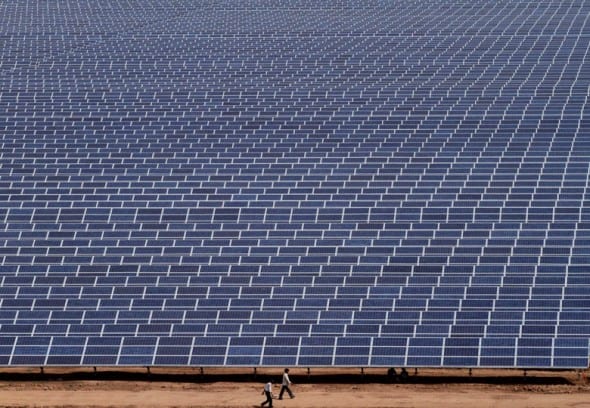 India’s Intended Nationally Determined Contribution (INDC) will see a fivefold increase in renewable energy in the world’s third largest electricity market by 2022, driving significant further cost reduction and innovation.
India’s Intended Nationally Determined Contribution (INDC) will see a fivefold increase in renewable energy in the world’s third largest electricity market by 2022, driving significant further cost reduction and innovation.
India has formally committed to lift renewable energy installations from the current 36GW fivefold to 175GW by 2022. In addition, India has announced a significant new target to take renewable installs to 40% of installed capacity by 2030, relative to only 13% today.
A tenfold increase in India’s renewable base will drive technology, innovation and cost reduction not just in India, but globally. And we have already seen a 70% drop in the installed cost of solar in the past five years.”
As IEEFA detailed in its August 2015 ‘India’s Electricity Sector Transformation’ report, well over US$100 billion has been committed in India’s renewable sector in 2015 alone.
Prime Minister Modi’s announcement is in line with what we already know about India’s rapid energy transition. A number of leading Indian firms have made significant new capital investment commitments to renewables.
ReNew Power, Welspun Energy, NTPC, Reliance Power, Tata Power and Suzlon Energy have collectively announced tens of billion dollars of proposed investments in Indian solar and wind projects in recent months.
Adani Enterprises has announced the world’s largest solar plant is already under construction in Tamil Nadu. Adani has announced a total of US$16 billion to be invested in solar in India across seven projects.
Major global corporates like Trina Solar, SunEdison, First Solar, ABB, Engie, Enel Green Power and China Light & Power are increasingly looking to accelerate this transformation by bringing global capital and technological expertise to India.
The joint SoftBank, Foxconn and Bharti Enterprises commitment to invest US$20bn over the next five years in Indian solar is a key milestone showing the international endorsement of this transformation. Momentum is clearly building with each month.
The transformation involves a rapid diversification of the electricity grid away from its current reliance on coal fired power generation. The INDC involves building renewable energy capacity to 40% of India’s total by 2030. With additional emphasis on expanding both hydro-electricity and nuclear in addition to renewables, thermal generation capacity will decline to 55% of the total by 2030, relative to its current 70% share.
IEEFA also sees India’s increased emphasis of energy efficiency as a key priority. India has committed to a new target to reduce emissions intensity of GDP by 33-35% by 2030 relative to the 2005 level, at step up from the 20-25% target by 2020.
The coal-fired power sector remains in India remains in serious financial distress, and utilisation rates have dropped to a new low of 58.4% in July 2015, not withstanding record high coal availability. Affordability and viability remain key obstacles.
With domestic coal production growth running at double electricity demand growth of 3% year on year to-date in 2015/16, inevitably coal imports have proven the swing factor. Reports show coal imports have declined 5% year on year in July-August 2015, in line with Energy Minister Piyush Goyal’s repeated pledge to end coal imports.
Renewable energy and energy efficiency fulfil a number of objectives for an Indian government focused on increasing energy access to the population and improving poor air quality in cities. Not only do they cut pollution, but they are also are deflationary, meaning they enhance the sustainability of India’s economic development and move the country away from its current fossil fuel energy reliance.
While India’s INDC was less aggressive than IEEFA has anticipated, it makes it clear that the ‘Common But Differentiated Responsibilities” needs to be understood in terms of global financial and technology support for India’s Electricity Sector Transformation. Global capital access is a key prerequisite.
As such, IEEFA would reference the two landmark Green Bond renewable issues last week by ReNew Wind Energy and Hindustan Power. The issues are the first to be done under the credit enhancement scheme of the Indian Infrastructure Finance Company Ltd providing the first loss partial credit guarantee to the bondholders along with an irrevocable back-stop guarantee with the Asian Development Bank.
The development of the Asia Infrastructure & Investment Bank will likewise accelerate the provision of global capital needed to underpin the Indian infrastructure investment required.
Tim Buckley is the Director of Energy Finance Studies, Australasia for IEEFA. He has 25 years of financial markets experience, including 17 years with Citigroup culminating in his role as Managing Director, Head of Australasian Equity Research.








